Archive for September, 2017

Curiosity Navcam Left B image acquired on Sol 1830, September 29, 2017.
Credit: NASA/JPL-Caltech
NASA’s Mars Curiosity rover has just entered Sol 1831.
In a report by Michael Battalio, an atmospheric scientist from Texas A&M University in College Station, the robot has performed touch-and-go science on a dark-toned target named “Collingham” in the hopes that the darker color indicated either a different chemistry or reduced surface dust.

“Tra Tra” is the large outcrop at the top left of the above image, with Mt. Sharp is to the right.
Curiosity Navcam Left B photo taken on Sol 1829, September 28, 2017.
Credit: NASA/JPL-Caltech
Curiosity’s Alpha Particle X-Ray Spectrometer (APXS), the Mars Hand Lens Imager (MAHLI), the Chemistry and Camera (ChemCam) and the rover’s Mastcam will all cooperate on observing this target.
Imaging campaign
The rover’s Mastcam will continue a Vera Rubin Ridge imaging campaign by capturing a 13×1 mosaic of a prominent outcrop, named “Tra Tra,” which is a large outcrop. A stereo image was to be taken to ascertain the geometry of the bedding.
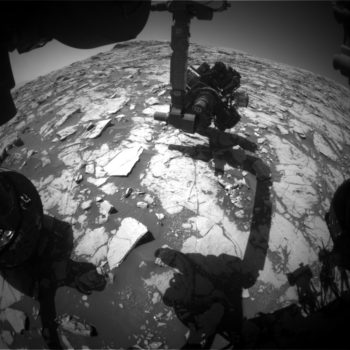
Curiosity Front Hazcam Left B image taken on Sol 1830, September 29, 2017.
Credit: NASA/JPL-Caltech
Curiosity was then slated to drive about 35 feet (11 meters) towards the top of a nearby ridge. Post-drive Navcam imaging is to be taken as well as use of automated software for imaging, Battalio reports.

Curiosity Mastcam Right image acquired on Sol 1828, September 27, 2017.
Credit: NASA/JPL-Caltech/MSSS
New map
A new map has been posted showing the route driven by Curiosity through the 1827 Martian day, or sol, of the rover’s mission on Mars – as of September 27, 2017.

Credit: NASA/JPL-Caltech
Numbering of the dots along the line indicate the sol number of each drive North is up. The scale bar is 1 kilometer mile From Sol 1822 to Sol 1827.
Curiosity had driven a straight line distance of about 30.86 feet (41 meters) bringing the rover’s total odometry for the mission to 10.84 miles (17.45 kilometers).
The base image from the map is from the High Resolution Imaging Science Experiment Camera (HiRISE) on NASA’s Mars Reconnaissance Orbiter.

Credit: Elon Musk/SpaceX
This week at the International Astronautical Congress (IAC) in Adelaide, Australia, SpaceX CEO and Lead Designer Elon Musk provided an update to his 2016 presentation regarding the long-term technical challenges that need to be solved to support the creation of a permanent, self-sustaining human presence on Mars.

Credit: Elon Musk/SpaceX
Moon, Mars, Earth-to-Earth
Musk spotlighted his “BFR” plans, a vehicle capable of transporting satellites to orbit, crew and cargo to the space station and completing missions to the Moon and Mars.

Credit: Elon Musk/SpaceX
Also, the SpaceX BFR will be capable of taking people from any city to any other city on Earth in under one hour.
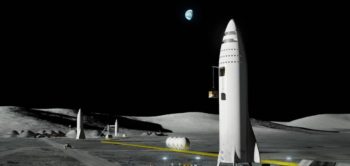
Credit: Elon Musk/SpaceX
“In Musk we Trust,” responded one viewer. “Maybe this presentation will be for Mars, what Kennedy’s speech was for the Apollo program,” said another.

Credit: Elon Musk/SpaceX
Resources
To view the Musk presentation, go to:
https://www.youtube.com/watch?time_continue=17&v=S5V7R_se1Xc
Go to SpaceX masterplan for Mars video at:
https://twitter.com/twitter/statuses/913634039545847808
Go to BFR – Earth to Earth video at:
For an expert review of Elon Musk’s talk go to this Australian Science Channel analysis straight after his SpaceX presentation.
Joining host and astronomer Alan Duffy is Adam Gilmour, CEO of Aussie space start up Gilmour Space Technologies, Michael Lopez-Alegria, NASA astronaut, and Beth Jens, propulsions engineer.
Go to:
https://www.facebook.com/RiAus/videos/10155810461416462/
Lastly, a critique of the SpaceX Interplanetary Transport System and Colonizing Mars by Robert Zubrin, leader of the Mars Society, is available here at:
http://www.thenewatlantis.com/publications/colonizing-mars
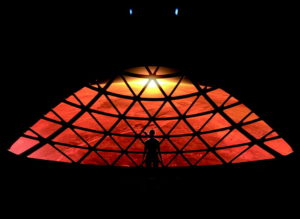
Credit: Elon Musk/SpaceX
This week at the International Astronautical Congress (IAC) in Adelaide, Australia, SpaceX CEO and Lead Designer Elon Musk will provide an update to his 2016 presentation regarding the long-term technical challenges that need to be solved to support the creation of a permanent, self-sustaining human presence on Mars.
You can watch the talk live on Thursday, September 28th at 9:30 p.m. PDT,
or Friday, September 29th at 2:00 p.m. ACST in Adelaide, Australia.
Go to: http://www.spacex.com/mars

Credit: Lockheed Martin
Mars Base Camp is Lockheed Martin’s concept for sending humans to Mars in about a decade. Using NASA’s Orion spacecraft as the command deck, the orbiting outpost could give scientists/astronauts the ability to operate rovers and drones on the Red Planet’s in real time.
Lockheed Martin is rolling out new details of the concept at the International Astronautical Congress now underway in Adelaide, Australia.
Mission architecture
According to the company, Mars Base Camp is a vision of how to send humans to Mars in about a decade – a mission architecture centered around an orbital outpost where scientist-astronauts can perform real-time scientific exploration of Mars.
Mars Base Camp is aligned with NASA’s recently-announced lunar Deep Space Gateway approach for developing and testing systems, including Orion, in cis-lunar space before using them to go to Mars. The Gateway allows astronauts to live and work in orbit around the Moon for months at a time while gaining experience with extended operations far from Earth.
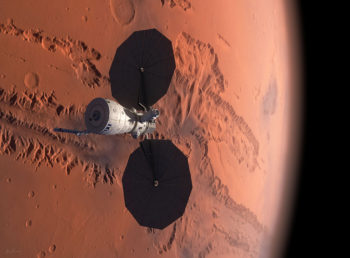
Credit: Lockheed Martin
First mission
“Mars Base Camp’s first mission is intended to be an orbiting mission around the Red Planet. Following this, the architecture allows for a surface lander. The concept is designed to be a reusable, single-stage lander capable of descending to the surface from Mars orbit,” states a company press statement. “Each surface mission could last two weeks with up to four astronauts, and then return to the orbiting Mars Base Camp where it would be refueled and readied for another mission.”
A webcast (live or replay) of the Mars Base Camp presentation from the Australian space gathering can be viewed on the Australia Science Channel web site:
https://www.australiascience.tv/live-from-the-68th-iac-lockheed-martins-mission-to-mars/
Here’s a video about Mars Base Camp:
https://www.youtube.com/watch?v=vLpZUMfIJX0
For more information on this innovative approach to human exploration of Mars, go to my older Space.com story at:
‘Mars Base Camp’: Lockheed Fleshes Out Red Planet Space Station Plan
By Leonard David, Space.com’s Space Insider Columnist
April 3, 2017 08:00am ET
http://www.space.com/36312-mars-base-camp-astronauts-2028.html

Curiosity Navcam Left B image taken on Sol 1828, September 27, 2017.
Credit: NASA/JPL-Caltech
NASA’s Curiosity rover on Mars is now in Sol 1829.
“We have officially left the ‘Bar Harbor’ quadrangle and are now into the ‘Kuruman’ quadrangle,” reports Abigail Fraeman, a planetary geologist at the NASA Jet Propulsion Laboratory in Pasadena, California.
Fraeman notes that during the first full sol in the Kuruman quad, the rover will be doing a touch-and-go.
Erosion-resistant outcrop
The robot is slated to investigate the target “Enon” with its Alpha Particle X-Ray Spectrometer (APXS) and the Mars Hand Lens Imager (MAHLI), the Chemistry and Camera (ChemCam) and use its Mastcam.
“We are also currently sitting in front of an erosion-resistant outcrop, ‘Mt. Hamden,’ which is providing us with a nice vertical exposure that we will image with Mastcam left and right eyes,” Fraeman says.
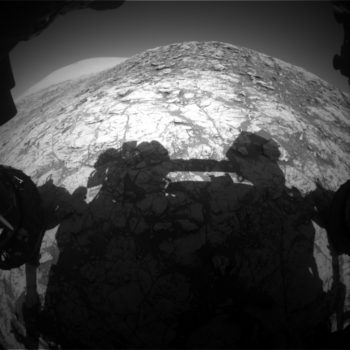
Curiosity Front Hazcam Left B image acquired on Sol 1828, September 27, 2017.
Credit: NASA/JPL-Caltech
Finally, another Mastcam image of target “Noisy” will be taken before the robot drives off to the northeast.
The day will end with some environmental science monitoring observations including a Mastcam tau measurement to assess the dust content of the atmosphere, and some Navcam images looking towards the sky and crater rim, Fraeman says.
Iron formation
Regarding the Kuruman quadrangle, Fraeman notes it is named after a charming town situated on the edge of the Kalahari desert in South Africa. Notably, the town of Kuruman is the namesake for the Kuruman Iron Formation, an ~2.46 billion year sedimentary rock that is rich in hematite.

Curiosity Navcam Right B photo taken on Sol 1828, September 27, 2017.
Credit: NASA/JPL-Caltech
“Hematite is the same mineral we can see is distributed throughout the Vera Rubin Ridge from orbital data! The target names we will use while in this quadrangle are pulled from famous geological features from South Africa and nearby Botswana and Zimbabwe,” Fraeman concludes.

This picture of the Curiosity arm’s shadow on the ground was taken just before a fault.
Front Hazcam Right B image taken on Sol 1826, September 25, 2017.
Credit: NASA/JPL-Caltech
Now in Sol 1827, NASA’s Curiosity rover has faulted itself and is staying put on Vera Rubin Ridge.
“Just when we thought we were going to leave this spot on Mars, we found ourselves stuck here for yet another sol,” reports Scott Guzewich, an atmospheric scientist at NASA’s Goddard Space Flight Center in Greenbelt, Maryland.
Recovery mode
This time, a fault during one of Curiosity’s arm activities caused scientists to toss out plans for the past two sols. Those plans included a drive of the robot to the next waypoint in the Vera Rubin Ridge science campaign.
Curiosity is in a recovery mode, Guzewich adds. For Sol 1827, “It’s déjà vu all over again.”

Curiosity Navcam Left B photo acquired on Sol 1827, September 26, 2017.
Credit: NASA/JPL-Caltech
Third attempt
The current plan calls for Curiosity controllers to make their third attempt to complete science activities at the rover’s current stop, including Chemistry and Camera (ChemCam) and Mastcam targets of nearby bedrock: “Sherwood Forest”, “Tableland”, and “Troll Valley.”

Curiosity Rear Hazcam Right B Sol 1827 September 26, 2017
Credit: NASA/JPL-Caltech
“We were also able to plan a Mastcam image of a target named “Elf Woods” that was originally intended for the weekend plan, but had to be removed for power consideration,” Guzewich concludes. “Following these science activities, Curiosity will drive approximately 10 meters [33 feet] closer to our third stop on Vera Rubin Ridge.”

European Space Agency astronauts train in terrestrial lava tubes. Credit: ESA/L. Ricci
The first systematic comparison of lava tube candidates on the Earth, Moon and Mars has been completed. What’s the upshot for underground caves?
Lava tubes, underground caves created by volcanic activity, could provide protected habitats large enough to house streets on Mars or even towns on the Moon.
New research on lava tubes has been presented at the European Planetary Science Congress (EPSC) 2017 in Riga. The work is already being used in the European Space Agency’s astronaut training program.
Tunnel sizes
According to Riccardo Pozzobon in the Department of Geosciences at the University of Padova in Italy: “The comparison of terrestrial, lunar and martian examples shows that, as you might expect, gravity has a big effect on the size of lava tubes.”

Cave diving on Earth is spurring increased interest in use of lava tubes on the Moon and Mars.
Credit: ESA/S. Sechi
On Earth, Pozzobon says, lava tubes can be nearly 100 feet (thirty meters) across. In the lower gravity environment of Mars, there is evidence for lava tubes that are 820 feet (250 meters) in width. “On the Moon, these tunnels could be a kilometer or more across and many hundreds of kilometers in length.”
“These results have important implications for habitability and human exploration of the Moon but also for the search of extraterrestrial life on Mars,” Pozzobon adds. “Lava tubes are environments shielded from cosmic radiation and protected from micrometeorites flux, potentially providing safe habitats for future human missions. They are also, potentially, large enough for quite significant human settlements.”

Artist’s impression of the radar instrument to probe for lava tubes beneath the lunar surface.
Credit: NASA/U. Trento
Lunar radar system
In a separate talk at EPSC, Leonardo Carrer and colleagues of the University of Trento in Italy presented a concept for a radar system specifically designed to detect lava tubes on the Moon from orbit.
A mission carrying this instrument “would enable a crucial step towards finding safe habitats on the Moon for human colonization,” Carrer reports.
Go to this video detailing the European Space Agency’s Pangaea 2016 cave work:
https://www.youtube.com/watch?v=fWsUHjVDJbY

Courtesy: Mars City Design
The Mars City Design group is working hard to provide an innovation platform for thought leaders to share and develop their ideas into sustainable products, with the dream to build a city and the lifestyles for the Red Planet, for Earth and beyond.
A 2nd Annual Gala Award Ceremony 2017 is being staged this October, featuring 2017 winners, space experts, and Mars pioneers, as well as some Hollywood celebrities.

Credit: Mars City Design
Eighth sense: biotune
According to Vera Mulyani, CEO & Founder of Mars City Design, a 2016 winner in the health category just received funding for a new venture, Eighth Sense. “This company will develop an innovative biotune device to help maintain the psychological wellbeing of our astronauts during the long duration of flight.”
This year, the winning designs of Mars City Challenges 2017 will be spotlighted in an October 12 gala/fund raiser, held at the Skirball Cultural Center in Los Angeles, California. Attire: “something red, strange, fun, and shiny.”

Credit: National Geographic
Honorary guest
An honorary guest for this upcoming event is Sammi Rotibi, a major actor in the Ron Howard National Geographic-produced series MARS and Quentin Tarantino’s Django Unchained.
For more information, go to:
Also, check out the 2017 Mars City Designs at:
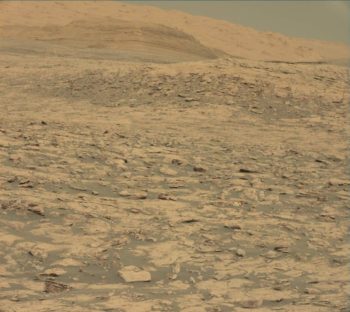
Curiosity Mastcam Left image acquired on Sol 1822, September 21, 2017.
Credit: NASA/JPL-Caltech/MSSS
NASA’s Mars Curiosity rover is now carrying out Sol 1824 duties.
“Curiosity continues her traverse across the lowermost portions of Vera Rubin Ridge, where she continues to investigate the interesting rock textures and colors ahead,” reports Mark Salvatore, a planetary geologist from the University of Michigan in Dearborn. “Our current location is quite dusty, which motivated the science team to focus on a relatively quick characterization of the surrounding bedrock.”

Curiosity Mastcam Left photo taken on Sol 1822, September 21, 2017.
Credit: NASA/JPL-Caltech/MSSS
Before a rover drive, Curiosity was on tap to create a high-resolution Mastcam mosaic of a region to the southwest of its current location.
“This region was identified from orbit as a potential region of interest, as it shows a relatively steep slope with some potentially interesting bedrock exposures,” Salvatore notes. “Ever since ascending onto Vera Rubin Ridge, Curiosity has been making progress towards this location to determine whether it is worth investigating from close-range.”
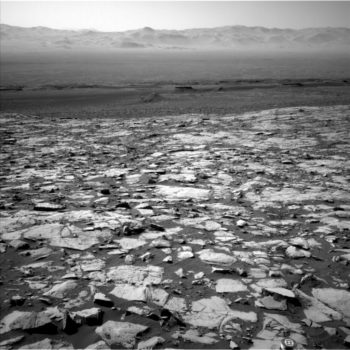
Curiosity Navcam Left B photo taken on Sol 1822, September 21, 2017.
Credit: NASA/JPL-Caltech
Blanket the area
Salvatore explains that the region doesn’t appear all that different from the parts of the ridge that Curiosity has already been exploring. “So, instead of continuing the southwest drive towards this location, the team decided to blanket the area in high-resolution color imagery before turning to the east-southeast and towards another region of interest.”

Curiosity Front Hazcam Right B image acquired on Sol 1822, September 21, 2017.
Credit: NASA/JPL-Caltech
Updating the rover’s planned traverse path using both orbital and ground-based data is very common, Salvatore points out, “and this decision by the science team highlights how collaborative discussions and the ability to adjust plans in real-time can both save time and maximize the scientific return of the mission.”
Uplink issue
A network communications problem on Earth, however, resulted in a Sol 1823 plan not being uplinked to the roving robot. That resulted in Curiosity performing a “runout” sol when only basic activities are performed, reports Scott Guzewich, an atmospheric scientist at NASA’s Goddard Space Flight Center in Greenbelt, Maryland.
“But we picked up right where we left off…and created a packed list of science activities to keep Curiosity busy over the weekend,” Guzewich adds. “We recovered the lost science on targets ‘Sherwood Forest’ and ‘Tableland’” which includes Chemistry and Camera (ChemCam) and Mastcam examinations of both and contact science on Sherwood Forest, he notes.
Fantasy-themed target
Another fantasy-themed named target was added in ‘Troll Valley’ that will be examined by contact science with the rover’s Mars Hand Lens Imager (MAHLI) and Alpha Particle X-Ray Spectrometer (APXS) and remotely by ChemCam and Mastcam.

Curiosity Rear Hazcam Right B photo taken on Sol 1822, September 21, 2017.
Credit: NASA/JPL-Caltech
Also planned was an extensive suite of environmental monitoring, including a ChemCam passive sky observation, Guzewich explains, where the ChemCam instrument is used without the laser to study atmospheric dust, ice, and gases.
Mastcam and Navcam images are to determine the amount of dust in the atmosphere as well as search for clouds. “We are entering the cloudy time of year on Mars and expect more clouds over the next several months,” Guzewich says.
Curiosity is slated to drive to the third stop of its Vera Rubin Ridge science campaign, stopping near a small, dark-toned ridge.
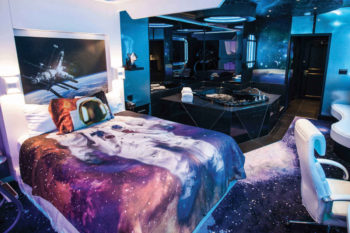
In space sleep time. Courtesy: Fodor’s Travel
Fodor’s Travel has posted an engaging story on space-themed rooms and suites at various price points that can be booked.
“Some merely nod to the theme, while others fully embrace it. Whether you’re traveling with a crew or Han Solo, these 10 picks will have you adding Tang and a spacesuit to your packing list,” writes Michele Shapiro, the author of “Room service to Major Tom!”

Courtesy: Fodor’s Travel
Immersive hotel
The article lifts off by looking at the immersive hotel in Orlando that will open as part of Star Wars: Galaxy’s Edge, the highly anticipated addition to Walt Disney World, “which promises to put guests smack in the middle of a battle between the First Order and the Resistance.”
Go to:
http://www.fodors.com/news/photos/stay-in-outer-space-right-here-on-earth

